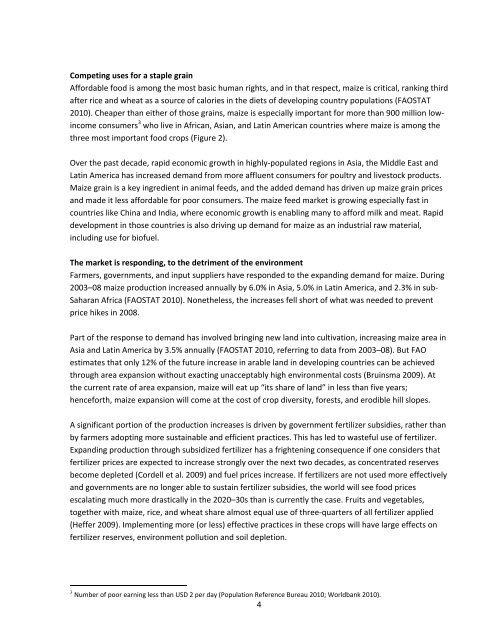Download - Maize
Download - Maize
Download - Maize
Create successful ePaper yourself
Turn your PDF publications into a flip-book with our unique Google optimized e-Paper software.
Competing uses for a staple grain<br />
Affordable food is among the most basic human rights, and in that respect, maize is critical, ranking third<br />
after rice and wheat as a source of calories in the diets of developing country populations (FAOSTAT<br />
2010). Cheaper than either of those grains, maize is especially important for more than 900 million lowincome<br />
consumers 3 who live in African, Asian, and Latin American countries where maize is among the<br />
three most important food crops (Figure 2).<br />
Over the past decade, rapid economic growth in highly‐populated regions in Asia, the Middle East and<br />
Latin America has increased demand from more affluent consumers for poultry and livestock products.<br />
<strong>Maize</strong> grain is a key ingredient in animal feeds, and the added demand has driven up maize grain prices<br />
and made it less affordable for poor consumers. The maize feed market is growing especially fast in<br />
countries like China and India, where economic growth is enabling many to afford milk and meat. Rapid<br />
development in those countries is also driving up demand for maize as an industrial raw material,<br />
including use for biofuel.<br />
The market is responding, to the detriment of the environment<br />
Farmers, governments, and input suppliers have responded to the expanding demand for maize. During<br />
2003–08 maize production increased annually by 6.0% in Asia, 5.0% in Latin America, and 2.3% in sub‐<br />
Saharan Africa (FAOSTAT 2010). Nonetheless, the increases fell short of what was needed to prevent<br />
price hikes in 2008.<br />
Part of the response to demand has involved bringing new land into cultivation, increasing maize area in<br />
Asia and Latin America by 3.5% annually (FAOSTAT 2010, referring to data from 2003–08). But FAO<br />
estimates that only 12% of the future increase in arable land in developing countries can be achieved<br />
through area expansion without exacting unacceptably high environmental costs (Bruinsma 2009). At<br />
the current rate of area expansion, maize will eat up “its share of land” in less than five years;<br />
henceforth, maize expansion will come at the cost of crop diversity, forests, and erodible hill slopes.<br />
A significant portion of the production increases is driven by government fertilizer subsidies, rather than<br />
by farmers adopting more sustainable and efficient practices. This has led to wasteful use of fertilizer.<br />
Expanding production through subsidized fertilizer has a frightening consequence if one considers that<br />
fertilizer prices are expected to increase strongly over the next two decades, as concentrated reserves<br />
become depleted (Cordell et al. 2009) and fuel prices increase. If fertilizers are not used more effectively<br />
and governments are no longer able to sustain fertilizer subsidies, the world will see food prices<br />
escalating much more drastically in the 2020–30s than is currently the case. Fruits and vegetables,<br />
together with maize, rice, and wheat share almost equal use of three‐quarters of all fertilizer applied<br />
(Heffer 2009). Implementing more (or less) effective practices in these crops will have large effects on<br />
fertilizer reserves, environment pollution and soil depletion.<br />
3 Number of poor earning less than USD 2 per day (Population Reference Bureau 2010; Worldbank 2010).<br />
4

















